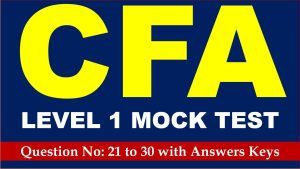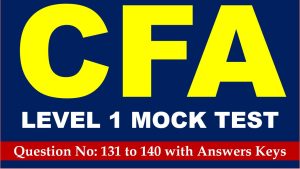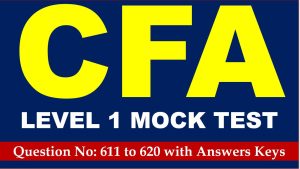Hi CFA Aspirants, welcome to AKVTutorials. Are you preparing for CFA Level 1, 2, 3 exams for making a career in CFA (Charted Financial Analyst). According to CFA Wikipedia, CFA The Chartered Financial Analyst (CFA) program is a postgraduate professional certification offered internationally by the American-based CFA Institute. A candidate who successfully completes the program and meets other professional requirements is awarded the “CFA charter” and becomes a “CFA charter holder”. Therefore, you need CFA Study Notes and Free CFA Level 1 Practice Test 24 Questions Bank Answer Keys AMBIPi.
In this article, you will get Free CFA Level 1 Mock Exam Practice Questions.
Free CFA Level 1 Mock Practice Exam Questions Bank
Free CFA Level 1 Practice Question No: 231:
Regarding Standard III (A), which of the following is true?
Option A : If the employer has publicly acknowledged, in writing, adoption of AIMR’s Code and Standards as part of its firm policies, then the member need not give formal written notification.
Option B : A member does not have to notify the supervisor, if the supervisor is a CFA charterholder.
Option C : Notification must be given to the chief operating officer (or equivalent), orally or in writing.
Option D : Notification must always be given, orally or in writing.
Option E :None of these answers is true.
Show/Hide Answer
Option A : A member does not have to notify the supervisor, if the supervisor is a CFA charterholder.
“Members shall inform their employer, in writing, through their direct supervisor, that they are obligated to comply with the Codes and Standards and are subject to disciplinary sanctions for violations thereof.” However, if the employer has publicly acknowledged, in writing, adoption of AIR’s Code and Standards as part of its firm policies, then the member need not give formal written notification.
Subordinate employees cannot assume that their supervisors are aware of the obligations, even if the supervisors are AIMR members.
CFA Level 1 Exam Question No: 232:
Standard III of the Standards of Professional Conduct deals with Relationships with and Responsibilities to ________
Option A: AIMR.
Option B: Clients and Prospects.
Option C: None of these answers.
Option D: the Employer.
Show/Hide Answer
Option D : the Employer.
Standard III of the Standards of Professional Conduct deals with Relationships with and Responsibilities to the Employer.
Free CFA Level 1 Mock Exam Question No: 233:
Standard IV (B.8) deals with ________.
Option A: Prohibition against Use of Material Nonpublic Information.
Option B: Preservation of Confidentiality.
Option C: None of these answers.
Option D: Prohibition against Misrepresentation.
Option E: Disclosure of Referral Fees.
Option F: Disclosure of Conflicts to Clients and Prospects.
Option G: Priority of Transactions.
Show/Hide Answer
Option E : Disclosure of Referral Fees.
Standard IV (B.8) states that members shall disclose to all clients any referral fees received by the member for the recommendation of any services to the client or prospect.
CFA Level 1 Free Practice Question No: 234:
Which of the following statements is NOT correct?
Option A: Members who work in a country where the Code and Standards impose a lesser degree of responsibility than local laws and regulations must still adhere to the Code and Standards.
Option B: All of these statements are correct.
Option C: Standards II through V address specific conduct.
Option D:Standard I sets forth minimum standards relating to general activities.
Show/Hide Answer
Option A : Members who work in a country where the Code and Standards impose a lesser degree of responsibility than local laws and regulations must still adhere to the Code and Standards.
If a member lives in a country, or provides investment services to a client residing in a country, with more strict securities laws than the Codes and Standards, he/ she must comply with the more strict laws and regulations of the country.
Free CFA Practice Question No: 235:
Which of the following is NOT a form of plagiarism as defined by AIMR code of conduct?
Option A: Copying proprietary software programs without permission.
Option B: Using data from a well-known statistical service without attribution.
Option C: Citing specific quotations to “leading analysts,” without specific reference.
Option D: Using publicized research reports prepared by others without attribution.
Show/Hide Answer
Option B :
Standard II(C) – Prohibition against Plagiarism considers a use of factual information published by recognized financial and statistical services without attribution acceptable. All of the others are forms of plagiarism and violations of Standard II(C).
CFA Level 1 Sample Question No: 236:
Silverio Arvantis is an aggressive and quick-silver analyst with Foresi Associates, an investment advisory firm. Silverio, a freshly minted Ph.D. from the University of Chicago, recently formulated an algorithm for selecting the portfolio weights in relatively new high-tech stocks. The algorithm evaluates 43 different variables to choose the investments and as such, is fairly complex in nature. Not wishing to drown his clients in esoteric terms like “martingale” and “stochastic transformation,” Silverio writes up a short report which touches only briefly on the major characteristics of the model. Instead, he focuses on the performance of the model on past market data, which is absolutely sterling. Based on these tests, Silverio recommends 4 stocks for immediate purchase. Silverio has:
Option A: violated Standard V (B) – Performance Presentation by relying on past data.
Option B: not violated any standards.
Option C: violated Standard IV (A.2) – Research Reports by failing to disclose sufficient details about the algorithm.
Option D: violated Standard IV (A.2) – Research Reports by failing to distinguish opinion from fact.
Show/Hide Answer
Option C : violated Standard IV (A.2) – Research Reports by failing to disclose sufficient details about the algorithm.
Standard IV (A.2) requires the member to disclose details of the reasoning and logic behind the recommendations so that investors can follow and challenge it and analyze the risks inherent in the recommended strategy. While Silverio does not have to delve into excessive technical details or reveal any proprietary formulas, the report must contain explanations for the recommendations. By omitting these, he has violated Standard IV (A.2). Note, however, that there is no evidence that he has confused opinion with fact.
Free CFA Level 1 Quiz Question NO: 237:
Parts of the standards that are _________ must be observed.
Option A: restraining.
Option B: mandatory.
Option C: recommended.
Option D: suggested.
Option E: inhibiting.
Show/Hide Answer
Option B : mandatory.
Some aspects of the Performance Presentation Standards are mandatory and must be observed, while other aspects are recommended.
Free CFA Level 1 Quiz Question NO: 238:
Standard III (B) deals with _______.
Option A: Use of Professional Designation.
Option B: Fundamental Responsibilities.
Option C: Professional Misconduct.
Option D: Disclosure of Conflicts to Employer.
Option E: None of these answers.
Option F: Duty to Employer.
Option G: Obligation to Inform Employer of Code and Standards.
Option H: Plagiarism.
Show/Hide Answer
Option F : Duty to Employer.
Standard I deals with Fundamental Responsibilities. Standard II (A) deals with Use of Professional Designation. Standard II (B deals with Professional Misconduct. Standard II (C) deals with Plagiarism. Standard III (A) deals with the Obligation to Inform Employer of Codes and Standards. Standard III (B) deals with the Duty to Employer. Standard III (C) deals with Disclosure of Conflicts to Employer.
Free CFA Practice Question No: 239:
When a manager is responsible for the portfolios of pension plans or trusts, the duty of loyalty is owed to the ________.
Option A: entity who hires the manager.
Option B: corporation.
Option C: none of these answers.
Option D: manager’s supervisor(s).
Option E: stockholders of the firm.
Option F: board of directors.
Option G: investing public.
Show/Hide Answer
Option C : none of these answers.
The first step in fulfilling a fiduciary duty is to determine what the responsibility is and to who it is owed. Members should take particular care in determining the identity of the “client” to whom the duty of loyalty is owed. In the context of an investment manager managing the portfolios of pension plans or trusts, the client is not the person or entity who hires the manager but, rather, the beneficiaries of the plan or trust. The duty of loyalty is owed to the beneficiaries.
CFA Mock Exam Free Question No: 230:
Standard IV (A) is known as _________.
Option A: Interactions with Clients and Prospects.
Option B: Preservation of Confidentiality.
Option C: Professional Misconduct.
Option D: Prohibition against Use of Material Nonpublic Information.
Option E: Duty to Employer.
Option F: Fair Dealing.
Option G: None of these answers.
Option H: Investment Process.
Show/Hide Answer
Option H : Investment Process.
Standard IV (A) deals with the Investment Process. Standard III (B) deals with Duty to Employer. Standard IV (B.3) deals with Fair Dealing. Standard IV (B) deals with Interactions with Clients and Prospects. Standard V (A) deals with Prohibition against Use of Material Nonpublic Information. Standard IV (B.5) deals with Preservation of Confidentiality. Standard II (B) deals with Professional Misconduct.



